The Importance of Health and Safety for Nurses in Hospitals
VerifiedAdded on 2021/05/31
|12
|3822
|175
Report
AI Summary
This report addresses the critical importance of health and safety for nurses within hospital environments. It highlights the various hazards nurses face, including respiratory issues, biological risks, drug exposure, and pathogen threats, and the impact these have on the nursing profession. The report emphasizes the need for robust health safety procedures, discussing the high injury rates and the need for improved safety measures, including the prevention of musculoskeletal injuries from patient lifting and exposure to bodily fluids. It argues that establishing and maintaining health and safety strategies is crucial for reducing costs, improving nurse motivation, and preventing work refusal. The report also explores the role of hospital management, health stakeholders, and government regulations in creating a safe working environment, including the importance of hygiene, protective equipment, and waste disposal protocols. The goal is to discuss the necessity of health and safety of all the nurses while working in the hospitals. The report concludes by highlighting the need for risk investigations, communication of hazards, and regular assessments to ensure a healthy and safe workplace for nurses, thereby contributing to the growth and efficiency of healthcare organizations.
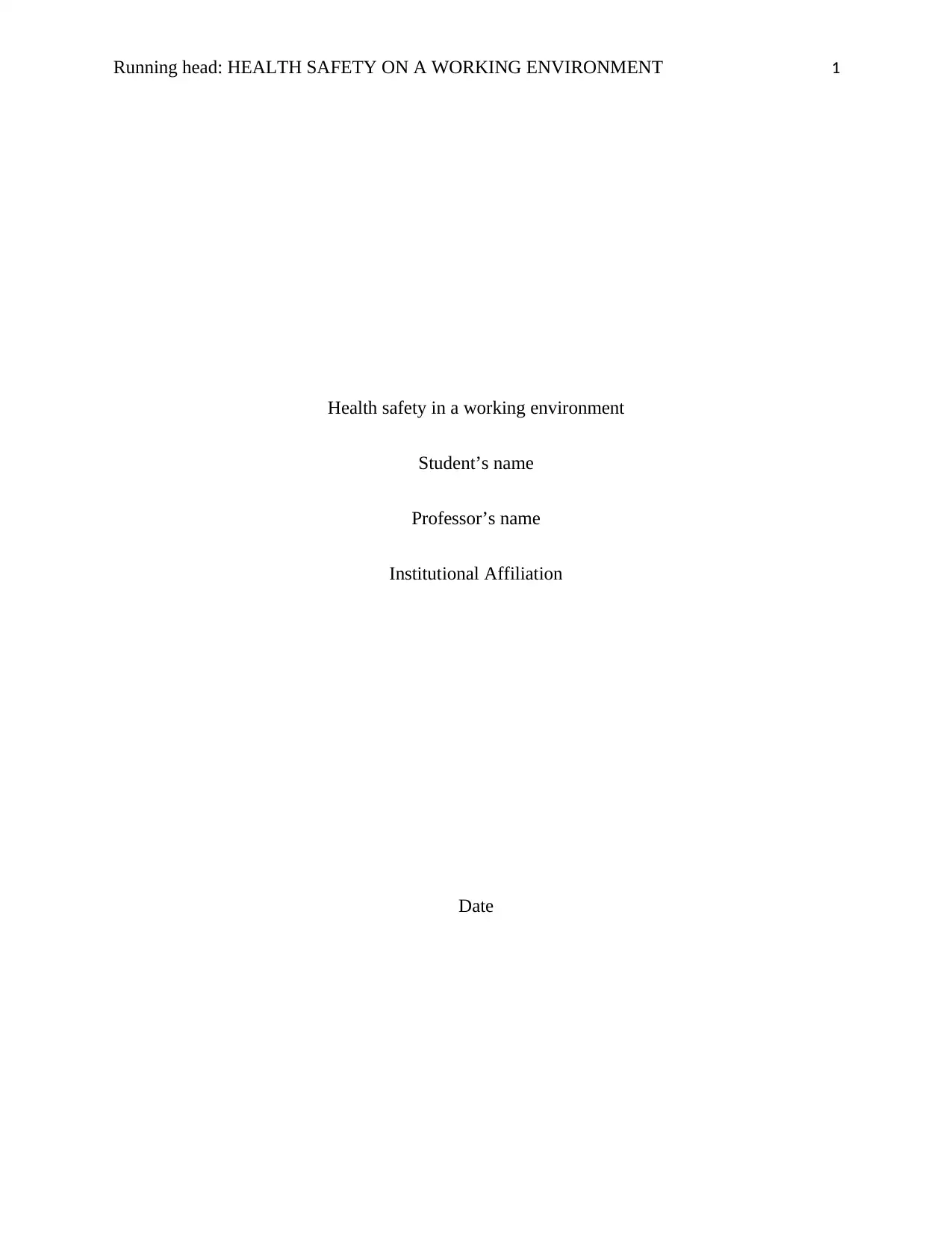
Running head: HEALTH SAFETY ON A WORKING ENVIRONMENT 1
Health safety in a working environment
Student’s name
Professor’s name
Institutional Affiliation
Date
Health safety in a working environment
Student’s name
Professor’s name
Institutional Affiliation
Date
Paraphrase This Document
Need a fresh take? Get an instant paraphrase of this document with our AI Paraphraser

HEALTH SAFETY ON A WORKING ENVIRONMENT 2
Health and safety of nurses in Hospital
The safety of the nurses at the hospital is the central issue of concern within the health
sectors. In nursing professional, health safety is necessary and an essential aspect of the quality
of the nursing care services. The emergence of the disease like Ebola and the anti-biotic
microorganism resistant have established a significant threat to the nursing profession within the
hospitals in the whole world. This makes it imagine how safe is the nursing profession. In this
century, one can assume the safety and the health of nurses within the hospital has been
addressed through the answer is not known (Yoon, Lin, Chen, Yi, Choi, & Rui 2013).
The statistics obtained from the BLS (Bureau of the labour statistic) has proven that the
health sector is one of the dangerous working places. Concerning OSHA (the occupational and
the health administration), the nurses have been confronted with the following health hazards,
the respiratory, biological, drug exposure and the pathogens and the laser hazards. In the year
2010, about 653900 nurses were injured and acquired illness in the line of their duties (Radke,
2016). For a very long period, there are significant instances, experiences in improving the safety
of the nurses. Therefore, more effort is the need for collecting and analysing in implementing
robust health safety-related procedures. The problem of the nurse safety has been manifested
throughout. For instance, the musculoskeletal illness and injuries experienced when lifting the
patients with not enough support. The nurse can even lift a weight of equal to 1.8 tons after a
period about 8 hours in a day. Unexpected exposure to fluids from the body of the patients poses
illness, and the infection causes a significant threat to the nursing profession every day. Errors
and injuries are the foreseen situations that affect the health professional and the other health
working staffs in the working places or any other field (Zaidi, Griffiths, Beshyah, Myers, &
Zaidi,2012). These injuries can as well happen within the hospital affecting the capability and the
Health and safety of nurses in Hospital
The safety of the nurses at the hospital is the central issue of concern within the health
sectors. In nursing professional, health safety is necessary and an essential aspect of the quality
of the nursing care services. The emergence of the disease like Ebola and the anti-biotic
microorganism resistant have established a significant threat to the nursing profession within the
hospitals in the whole world. This makes it imagine how safe is the nursing profession. In this
century, one can assume the safety and the health of nurses within the hospital has been
addressed through the answer is not known (Yoon, Lin, Chen, Yi, Choi, & Rui 2013).
The statistics obtained from the BLS (Bureau of the labour statistic) has proven that the
health sector is one of the dangerous working places. Concerning OSHA (the occupational and
the health administration), the nurses have been confronted with the following health hazards,
the respiratory, biological, drug exposure and the pathogens and the laser hazards. In the year
2010, about 653900 nurses were injured and acquired illness in the line of their duties (Radke,
2016). For a very long period, there are significant instances, experiences in improving the safety
of the nurses. Therefore, more effort is the need for collecting and analysing in implementing
robust health safety-related procedures. The problem of the nurse safety has been manifested
throughout. For instance, the musculoskeletal illness and injuries experienced when lifting the
patients with not enough support. The nurse can even lift a weight of equal to 1.8 tons after a
period about 8 hours in a day. Unexpected exposure to fluids from the body of the patients poses
illness, and the infection causes a significant threat to the nursing profession every day. Errors
and injuries are the foreseen situations that affect the health professional and the other health
working staffs in the working places or any other field (Zaidi, Griffiths, Beshyah, Myers, &
Zaidi,2012). These injuries can as well happen within the hospital affecting the capability and the
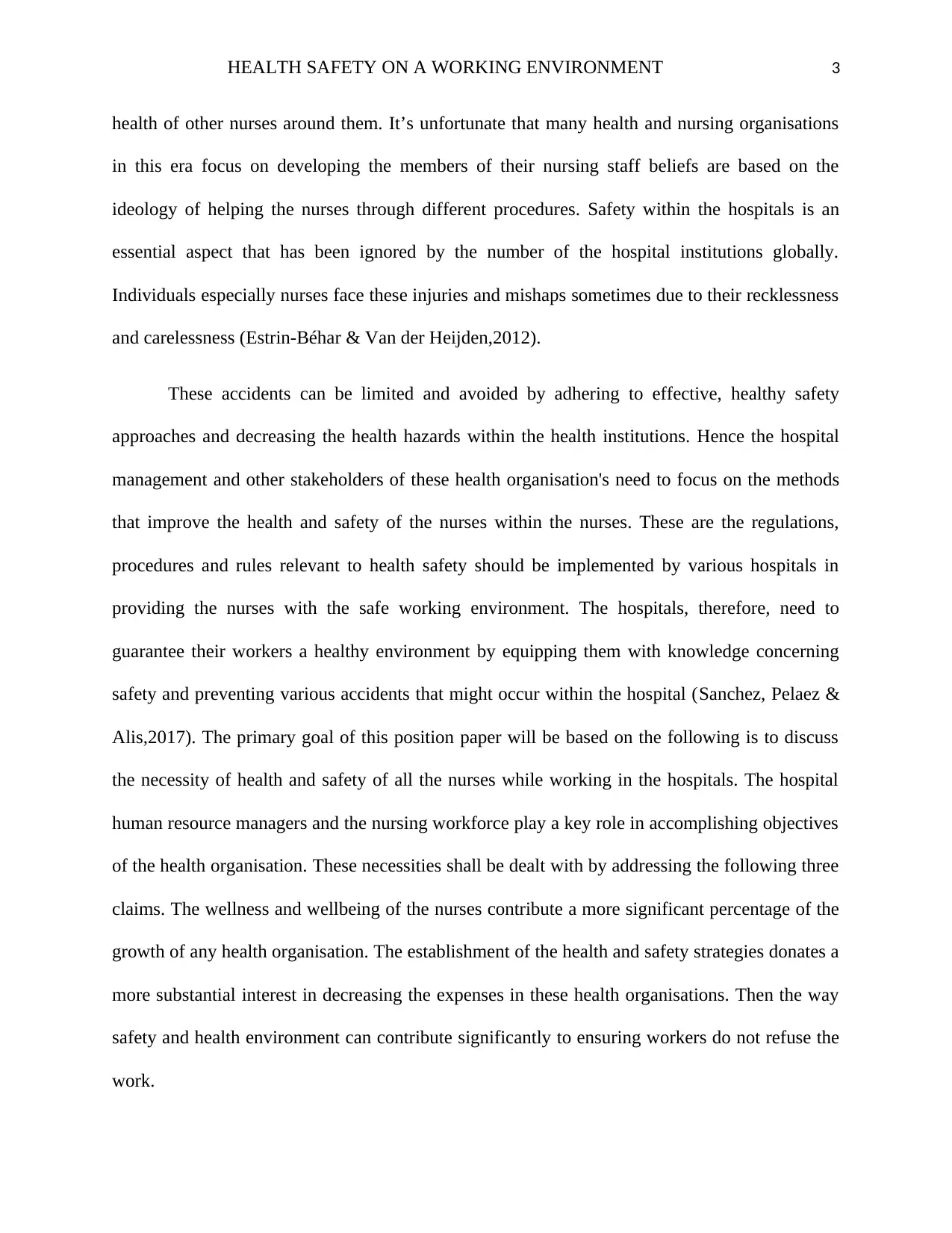
HEALTH SAFETY ON A WORKING ENVIRONMENT 3
health of other nurses around them. It’s unfortunate that many health and nursing organisations
in this era focus on developing the members of their nursing staff beliefs are based on the
ideology of helping the nurses through different procedures. Safety within the hospitals is an
essential aspect that has been ignored by the number of the hospital institutions globally.
Individuals especially nurses face these injuries and mishaps sometimes due to their recklessness
and carelessness (Estrin-Béhar & Van der Heijden,2012).
These accidents can be limited and avoided by adhering to effective, healthy safety
approaches and decreasing the health hazards within the health institutions. Hence the hospital
management and other stakeholders of these health organisation's need to focus on the methods
that improve the health and safety of the nurses within the nurses. These are the regulations,
procedures and rules relevant to health safety should be implemented by various hospitals in
providing the nurses with the safe working environment. The hospitals, therefore, need to
guarantee their workers a healthy environment by equipping them with knowledge concerning
safety and preventing various accidents that might occur within the hospital (Sanchez, Pelaez &
Alis,2017). The primary goal of this position paper will be based on the following is to discuss
the necessity of health and safety of all the nurses while working in the hospitals. The hospital
human resource managers and the nursing workforce play a key role in accomplishing objectives
of the health organisation. These necessities shall be dealt with by addressing the following three
claims. The wellness and wellbeing of the nurses contribute a more significant percentage of the
growth of any health organisation. The establishment of the health and safety strategies donates a
more substantial interest in decreasing the expenses in these health organisations. Then the way
safety and health environment can contribute significantly to ensuring workers do not refuse the
work.
health of other nurses around them. It’s unfortunate that many health and nursing organisations
in this era focus on developing the members of their nursing staff beliefs are based on the
ideology of helping the nurses through different procedures. Safety within the hospitals is an
essential aspect that has been ignored by the number of the hospital institutions globally.
Individuals especially nurses face these injuries and mishaps sometimes due to their recklessness
and carelessness (Estrin-Béhar & Van der Heijden,2012).
These accidents can be limited and avoided by adhering to effective, healthy safety
approaches and decreasing the health hazards within the health institutions. Hence the hospital
management and other stakeholders of these health organisation's need to focus on the methods
that improve the health and safety of the nurses within the nurses. These are the regulations,
procedures and rules relevant to health safety should be implemented by various hospitals in
providing the nurses with the safe working environment. The hospitals, therefore, need to
guarantee their workers a healthy environment by equipping them with knowledge concerning
safety and preventing various accidents that might occur within the hospital (Sanchez, Pelaez &
Alis,2017). The primary goal of this position paper will be based on the following is to discuss
the necessity of health and safety of all the nurses while working in the hospitals. The hospital
human resource managers and the nursing workforce play a key role in accomplishing objectives
of the health organisation. These necessities shall be dealt with by addressing the following three
claims. The wellness and wellbeing of the nurses contribute a more significant percentage of the
growth of any health organisation. The establishment of the health and safety strategies donates a
more substantial interest in decreasing the expenses in these health organisations. Then the way
safety and health environment can contribute significantly to ensuring workers do not refuse the
work.
⊘ This is a preview!⊘
Do you want full access?
Subscribe today to unlock all pages.

Trusted by 1+ million students worldwide
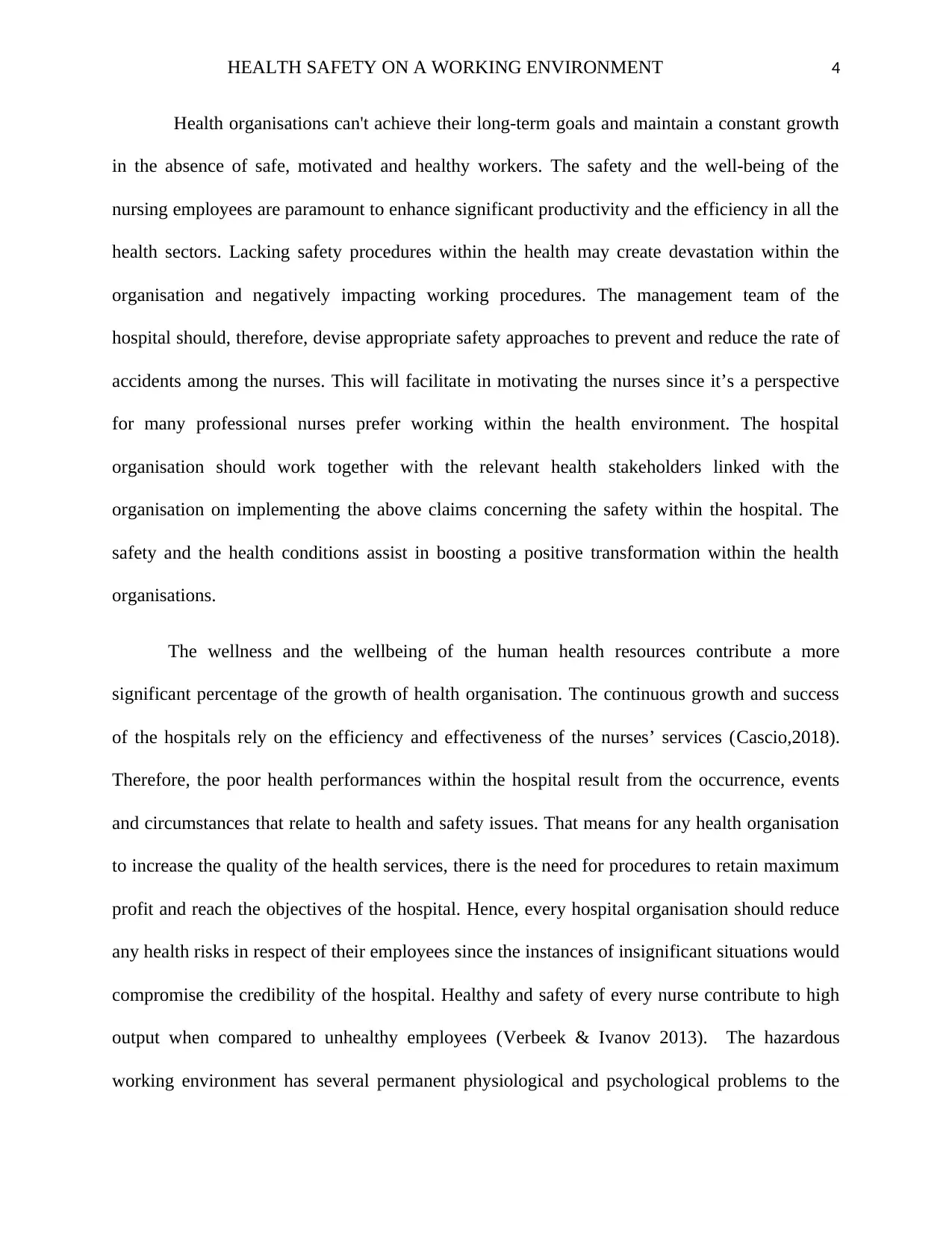
HEALTH SAFETY ON A WORKING ENVIRONMENT 4
Health organisations can't achieve their long-term goals and maintain a constant growth
in the absence of safe, motivated and healthy workers. The safety and the well-being of the
nursing employees are paramount to enhance significant productivity and the efficiency in all the
health sectors. Lacking safety procedures within the health may create devastation within the
organisation and negatively impacting working procedures. The management team of the
hospital should, therefore, devise appropriate safety approaches to prevent and reduce the rate of
accidents among the nurses. This will facilitate in motivating the nurses since it’s a perspective
for many professional nurses prefer working within the health environment. The hospital
organisation should work together with the relevant health stakeholders linked with the
organisation on implementing the above claims concerning the safety within the hospital. The
safety and the health conditions assist in boosting a positive transformation within the health
organisations.
The wellness and the wellbeing of the human health resources contribute a more
significant percentage of the growth of health organisation. The continuous growth and success
of the hospitals rely on the efficiency and effectiveness of the nurses’ services (Cascio,2018).
Therefore, the poor health performances within the hospital result from the occurrence, events
and circumstances that relate to health and safety issues. That means for any health organisation
to increase the quality of the health services, there is the need for procedures to retain maximum
profit and reach the objectives of the hospital. Hence, every hospital organisation should reduce
any health risks in respect of their employees since the instances of insignificant situations would
compromise the credibility of the hospital. Healthy and safety of every nurse contribute to high
output when compared to unhealthy employees (Verbeek & Ivanov 2013). The hazardous
working environment has several permanent physiological and psychological problems to the
Health organisations can't achieve their long-term goals and maintain a constant growth
in the absence of safe, motivated and healthy workers. The safety and the well-being of the
nursing employees are paramount to enhance significant productivity and the efficiency in all the
health sectors. Lacking safety procedures within the health may create devastation within the
organisation and negatively impacting working procedures. The management team of the
hospital should, therefore, devise appropriate safety approaches to prevent and reduce the rate of
accidents among the nurses. This will facilitate in motivating the nurses since it’s a perspective
for many professional nurses prefer working within the health environment. The hospital
organisation should work together with the relevant health stakeholders linked with the
organisation on implementing the above claims concerning the safety within the hospital. The
safety and the health conditions assist in boosting a positive transformation within the health
organisations.
The wellness and the wellbeing of the human health resources contribute a more
significant percentage of the growth of health organisation. The continuous growth and success
of the hospitals rely on the efficiency and effectiveness of the nurses’ services (Cascio,2018).
Therefore, the poor health performances within the hospital result from the occurrence, events
and circumstances that relate to health and safety issues. That means for any health organisation
to increase the quality of the health services, there is the need for procedures to retain maximum
profit and reach the objectives of the hospital. Hence, every hospital organisation should reduce
any health risks in respect of their employees since the instances of insignificant situations would
compromise the credibility of the hospital. Healthy and safety of every nurse contribute to high
output when compared to unhealthy employees (Verbeek & Ivanov 2013). The hazardous
working environment has several permanent physiological and psychological problems to the
Paraphrase This Document
Need a fresh take? Get an instant paraphrase of this document with our AI Paraphraser
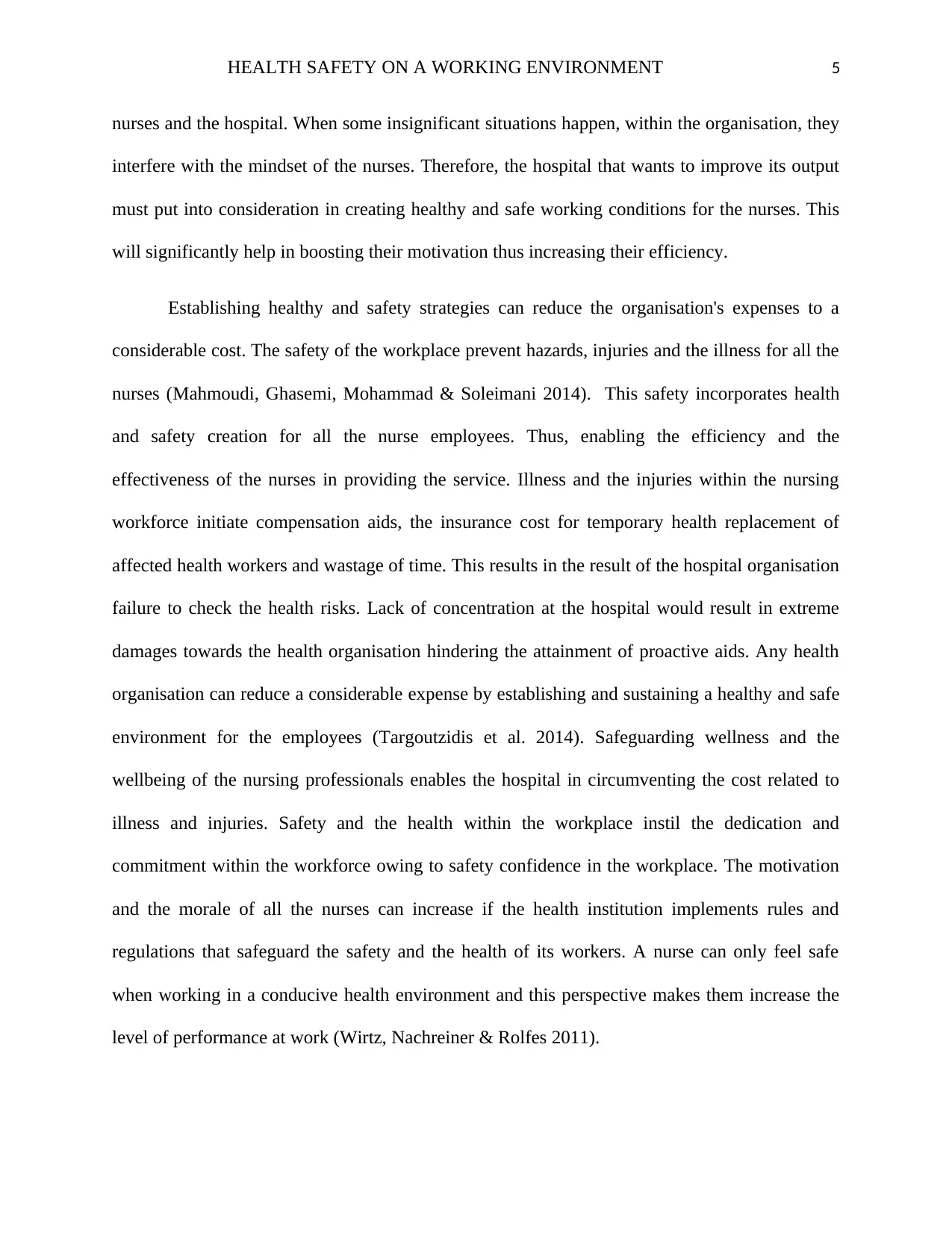
HEALTH SAFETY ON A WORKING ENVIRONMENT 5
nurses and the hospital. When some insignificant situations happen, within the organisation, they
interfere with the mindset of the nurses. Therefore, the hospital that wants to improve its output
must put into consideration in creating healthy and safe working conditions for the nurses. This
will significantly help in boosting their motivation thus increasing their efficiency.
Establishing healthy and safety strategies can reduce the organisation's expenses to a
considerable cost. The safety of the workplace prevent hazards, injuries and the illness for all the
nurses (Mahmoudi, Ghasemi, Mohammad & Soleimani 2014). This safety incorporates health
and safety creation for all the nurse employees. Thus, enabling the efficiency and the
effectiveness of the nurses in providing the service. Illness and the injuries within the nursing
workforce initiate compensation aids, the insurance cost for temporary health replacement of
affected health workers and wastage of time. This results in the result of the hospital organisation
failure to check the health risks. Lack of concentration at the hospital would result in extreme
damages towards the health organisation hindering the attainment of proactive aids. Any health
organisation can reduce a considerable expense by establishing and sustaining a healthy and safe
environment for the employees (Targoutzidis et al. 2014). Safeguarding wellness and the
wellbeing of the nursing professionals enables the hospital in circumventing the cost related to
illness and injuries. Safety and the health within the workplace instil the dedication and
commitment within the workforce owing to safety confidence in the workplace. The motivation
and the morale of all the nurses can increase if the health institution implements rules and
regulations that safeguard the safety and the health of its workers. A nurse can only feel safe
when working in a conducive health environment and this perspective makes them increase the
level of performance at work (Wirtz, Nachreiner & Rolfes 2011).
nurses and the hospital. When some insignificant situations happen, within the organisation, they
interfere with the mindset of the nurses. Therefore, the hospital that wants to improve its output
must put into consideration in creating healthy and safe working conditions for the nurses. This
will significantly help in boosting their motivation thus increasing their efficiency.
Establishing healthy and safety strategies can reduce the organisation's expenses to a
considerable cost. The safety of the workplace prevent hazards, injuries and the illness for all the
nurses (Mahmoudi, Ghasemi, Mohammad & Soleimani 2014). This safety incorporates health
and safety creation for all the nurse employees. Thus, enabling the efficiency and the
effectiveness of the nurses in providing the service. Illness and the injuries within the nursing
workforce initiate compensation aids, the insurance cost for temporary health replacement of
affected health workers and wastage of time. This results in the result of the hospital organisation
failure to check the health risks. Lack of concentration at the hospital would result in extreme
damages towards the health organisation hindering the attainment of proactive aids. Any health
organisation can reduce a considerable expense by establishing and sustaining a healthy and safe
environment for the employees (Targoutzidis et al. 2014). Safeguarding wellness and the
wellbeing of the nursing professionals enables the hospital in circumventing the cost related to
illness and injuries. Safety and the health within the workplace instil the dedication and
commitment within the workforce owing to safety confidence in the workplace. The motivation
and the morale of all the nurses can increase if the health institution implements rules and
regulations that safeguard the safety and the health of its workers. A nurse can only feel safe
when working in a conducive health environment and this perspective makes them increase the
level of performance at work (Wirtz, Nachreiner & Rolfes 2011).
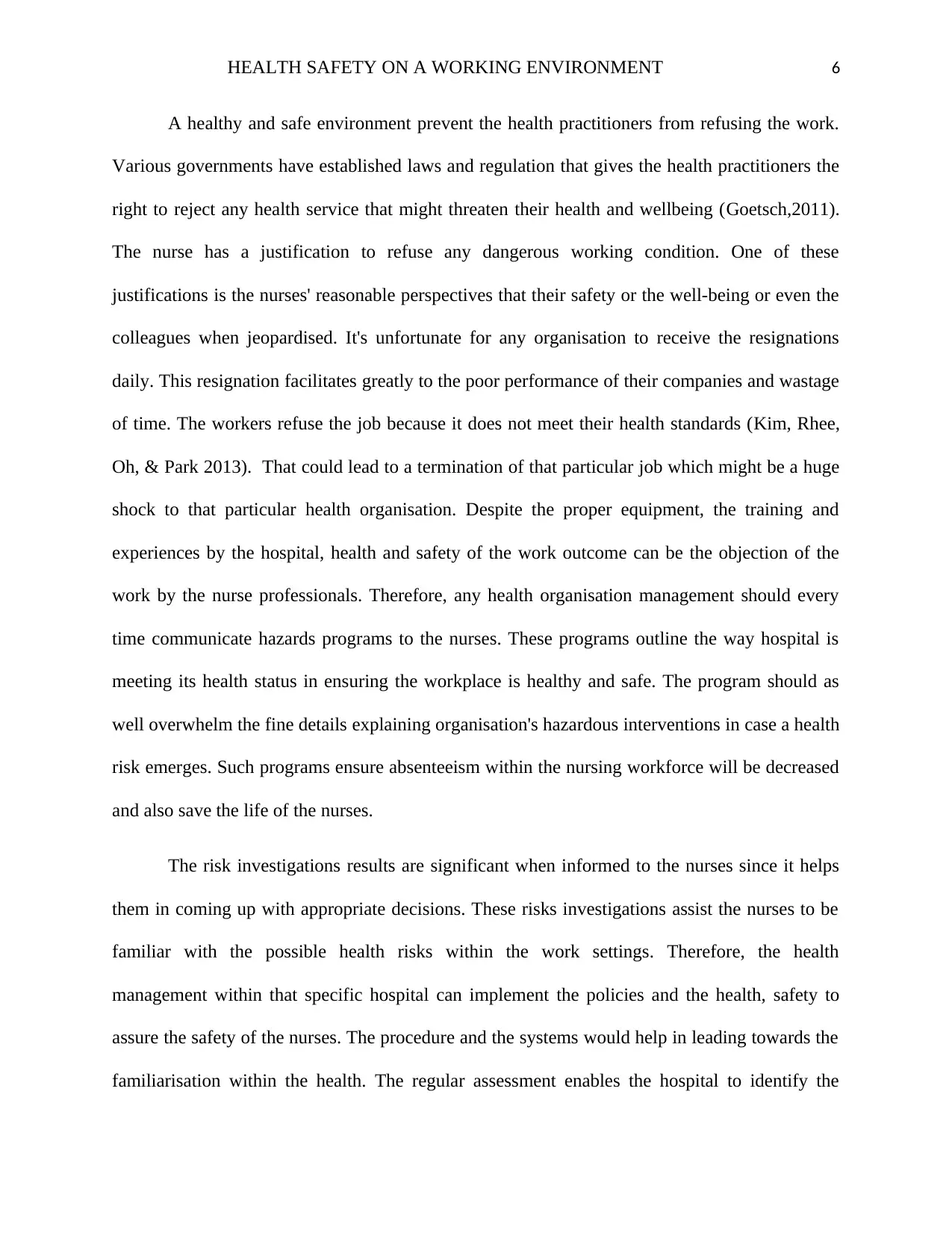
HEALTH SAFETY ON A WORKING ENVIRONMENT 6
A healthy and safe environment prevent the health practitioners from refusing the work.
Various governments have established laws and regulation that gives the health practitioners the
right to reject any health service that might threaten their health and wellbeing (Goetsch,2011).
The nurse has a justification to refuse any dangerous working condition. One of these
justifications is the nurses' reasonable perspectives that their safety or the well-being or even the
colleagues when jeopardised. It's unfortunate for any organisation to receive the resignations
daily. This resignation facilitates greatly to the poor performance of their companies and wastage
of time. The workers refuse the job because it does not meet their health standards (Kim, Rhee,
Oh, & Park 2013). That could lead to a termination of that particular job which might be a huge
shock to that particular health organisation. Despite the proper equipment, the training and
experiences by the hospital, health and safety of the work outcome can be the objection of the
work by the nurse professionals. Therefore, any health organisation management should every
time communicate hazards programs to the nurses. These programs outline the way hospital is
meeting its health status in ensuring the workplace is healthy and safe. The program should as
well overwhelm the fine details explaining organisation's hazardous interventions in case a health
risk emerges. Such programs ensure absenteeism within the nursing workforce will be decreased
and also save the life of the nurses.
The risk investigations results are significant when informed to the nurses since it helps
them in coming up with appropriate decisions. These risks investigations assist the nurses to be
familiar with the possible health risks within the work settings. Therefore, the health
management within that specific hospital can implement the policies and the health, safety to
assure the safety of the nurses. The procedure and the systems would help in leading towards the
familiarisation within the health. The regular assessment enables the hospital to identify the
A healthy and safe environment prevent the health practitioners from refusing the work.
Various governments have established laws and regulation that gives the health practitioners the
right to reject any health service that might threaten their health and wellbeing (Goetsch,2011).
The nurse has a justification to refuse any dangerous working condition. One of these
justifications is the nurses' reasonable perspectives that their safety or the well-being or even the
colleagues when jeopardised. It's unfortunate for any organisation to receive the resignations
daily. This resignation facilitates greatly to the poor performance of their companies and wastage
of time. The workers refuse the job because it does not meet their health standards (Kim, Rhee,
Oh, & Park 2013). That could lead to a termination of that particular job which might be a huge
shock to that particular health organisation. Despite the proper equipment, the training and
experiences by the hospital, health and safety of the work outcome can be the objection of the
work by the nurse professionals. Therefore, any health organisation management should every
time communicate hazards programs to the nurses. These programs outline the way hospital is
meeting its health status in ensuring the workplace is healthy and safe. The program should as
well overwhelm the fine details explaining organisation's hazardous interventions in case a health
risk emerges. Such programs ensure absenteeism within the nursing workforce will be decreased
and also save the life of the nurses.
The risk investigations results are significant when informed to the nurses since it helps
them in coming up with appropriate decisions. These risks investigations assist the nurses to be
familiar with the possible health risks within the work settings. Therefore, the health
management within that specific hospital can implement the policies and the health, safety to
assure the safety of the nurses. The procedure and the systems would help in leading towards the
familiarisation within the health. The regular assessment enables the hospital to identify the
⊘ This is a preview!⊘
Do you want full access?
Subscribe today to unlock all pages.

Trusted by 1+ million students worldwide
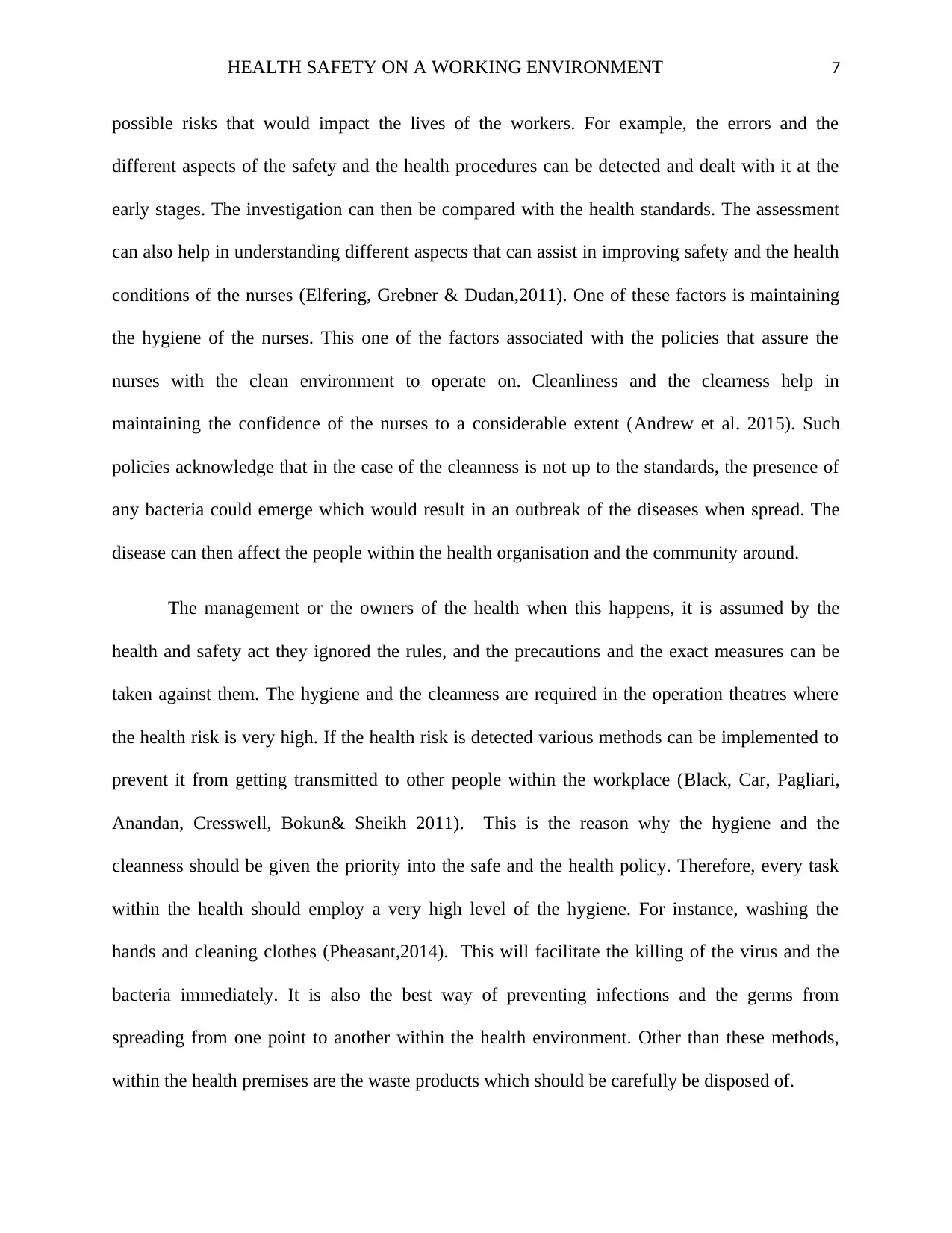
HEALTH SAFETY ON A WORKING ENVIRONMENT 7
possible risks that would impact the lives of the workers. For example, the errors and the
different aspects of the safety and the health procedures can be detected and dealt with it at the
early stages. The investigation can then be compared with the health standards. The assessment
can also help in understanding different aspects that can assist in improving safety and the health
conditions of the nurses (Elfering, Grebner & Dudan,2011). One of these factors is maintaining
the hygiene of the nurses. This one of the factors associated with the policies that assure the
nurses with the clean environment to operate on. Cleanliness and the clearness help in
maintaining the confidence of the nurses to a considerable extent (Andrew et al. 2015). Such
policies acknowledge that in the case of the cleanness is not up to the standards, the presence of
any bacteria could emerge which would result in an outbreak of the diseases when spread. The
disease can then affect the people within the health organisation and the community around.
The management or the owners of the health when this happens, it is assumed by the
health and safety act they ignored the rules, and the precautions and the exact measures can be
taken against them. The hygiene and the cleanness are required in the operation theatres where
the health risk is very high. If the health risk is detected various methods can be implemented to
prevent it from getting transmitted to other people within the workplace (Black, Car, Pagliari,
Anandan, Cresswell, Bokun& Sheikh 2011). This is the reason why the hygiene and the
cleanness should be given the priority into the safe and the health policy. Therefore, every task
within the health should employ a very high level of the hygiene. For instance, washing the
hands and cleaning clothes (Pheasant,2014). This will facilitate the killing of the virus and the
bacteria immediately. It is also the best way of preventing infections and the germs from
spreading from one point to another within the health environment. Other than these methods,
within the health premises are the waste products which should be carefully be disposed of.
possible risks that would impact the lives of the workers. For example, the errors and the
different aspects of the safety and the health procedures can be detected and dealt with it at the
early stages. The investigation can then be compared with the health standards. The assessment
can also help in understanding different aspects that can assist in improving safety and the health
conditions of the nurses (Elfering, Grebner & Dudan,2011). One of these factors is maintaining
the hygiene of the nurses. This one of the factors associated with the policies that assure the
nurses with the clean environment to operate on. Cleanliness and the clearness help in
maintaining the confidence of the nurses to a considerable extent (Andrew et al. 2015). Such
policies acknowledge that in the case of the cleanness is not up to the standards, the presence of
any bacteria could emerge which would result in an outbreak of the diseases when spread. The
disease can then affect the people within the health organisation and the community around.
The management or the owners of the health when this happens, it is assumed by the
health and safety act they ignored the rules, and the precautions and the exact measures can be
taken against them. The hygiene and the cleanness are required in the operation theatres where
the health risk is very high. If the health risk is detected various methods can be implemented to
prevent it from getting transmitted to other people within the workplace (Black, Car, Pagliari,
Anandan, Cresswell, Bokun& Sheikh 2011). This is the reason why the hygiene and the
cleanness should be given the priority into the safe and the health policy. Therefore, every task
within the health should employ a very high level of the hygiene. For instance, washing the
hands and cleaning clothes (Pheasant,2014). This will facilitate the killing of the virus and the
bacteria immediately. It is also the best way of preventing infections and the germs from
spreading from one point to another within the health environment. Other than these methods,
within the health premises are the waste products which should be carefully be disposed of.
Paraphrase This Document
Need a fresh take? Get an instant paraphrase of this document with our AI Paraphraser
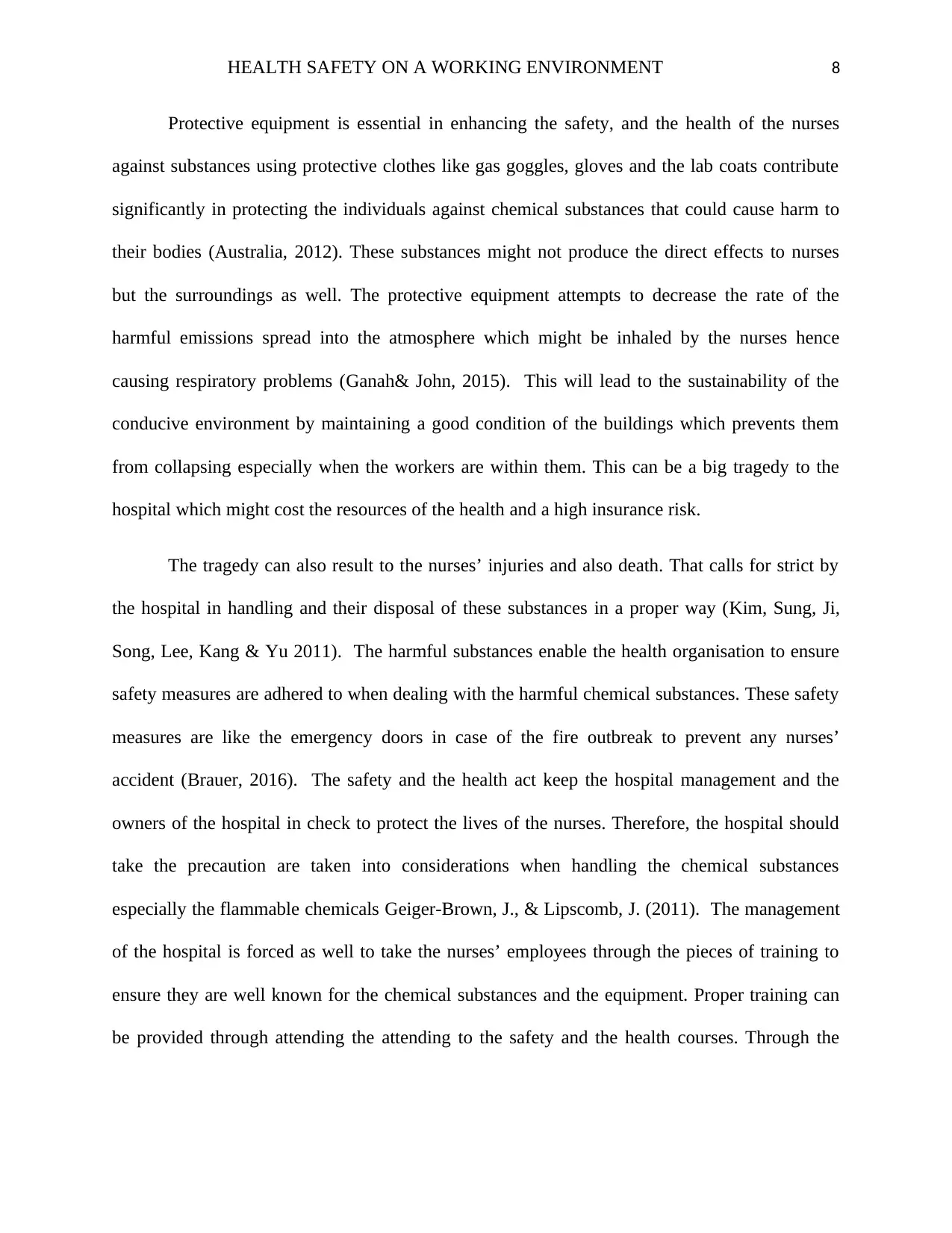
HEALTH SAFETY ON A WORKING ENVIRONMENT 8
Protective equipment is essential in enhancing the safety, and the health of the nurses
against substances using protective clothes like gas goggles, gloves and the lab coats contribute
significantly in protecting the individuals against chemical substances that could cause harm to
their bodies (Australia, 2012). These substances might not produce the direct effects to nurses
but the surroundings as well. The protective equipment attempts to decrease the rate of the
harmful emissions spread into the atmosphere which might be inhaled by the nurses hence
causing respiratory problems (Ganah& John, 2015). This will lead to the sustainability of the
conducive environment by maintaining a good condition of the buildings which prevents them
from collapsing especially when the workers are within them. This can be a big tragedy to the
hospital which might cost the resources of the health and a high insurance risk.
The tragedy can also result to the nurses’ injuries and also death. That calls for strict by
the hospital in handling and their disposal of these substances in a proper way (Kim, Sung, Ji,
Song, Lee, Kang & Yu 2011). The harmful substances enable the health organisation to ensure
safety measures are adhered to when dealing with the harmful chemical substances. These safety
measures are like the emergency doors in case of the fire outbreak to prevent any nurses’
accident (Brauer, 2016). The safety and the health act keep the hospital management and the
owners of the hospital in check to protect the lives of the nurses. Therefore, the hospital should
take the precaution are taken into considerations when handling the chemical substances
especially the flammable chemicals Geiger-Brown, J., & Lipscomb, J. (2011). The management
of the hospital is forced as well to take the nurses’ employees through the pieces of training to
ensure they are well known for the chemical substances and the equipment. Proper training can
be provided through attending the attending to the safety and the health courses. Through the
Protective equipment is essential in enhancing the safety, and the health of the nurses
against substances using protective clothes like gas goggles, gloves and the lab coats contribute
significantly in protecting the individuals against chemical substances that could cause harm to
their bodies (Australia, 2012). These substances might not produce the direct effects to nurses
but the surroundings as well. The protective equipment attempts to decrease the rate of the
harmful emissions spread into the atmosphere which might be inhaled by the nurses hence
causing respiratory problems (Ganah& John, 2015). This will lead to the sustainability of the
conducive environment by maintaining a good condition of the buildings which prevents them
from collapsing especially when the workers are within them. This can be a big tragedy to the
hospital which might cost the resources of the health and a high insurance risk.
The tragedy can also result to the nurses’ injuries and also death. That calls for strict by
the hospital in handling and their disposal of these substances in a proper way (Kim, Sung, Ji,
Song, Lee, Kang & Yu 2011). The harmful substances enable the health organisation to ensure
safety measures are adhered to when dealing with the harmful chemical substances. These safety
measures are like the emergency doors in case of the fire outbreak to prevent any nurses’
accident (Brauer, 2016). The safety and the health act keep the hospital management and the
owners of the hospital in check to protect the lives of the nurses. Therefore, the hospital should
take the precaution are taken into considerations when handling the chemical substances
especially the flammable chemicals Geiger-Brown, J., & Lipscomb, J. (2011). The management
of the hospital is forced as well to take the nurses’ employees through the pieces of training to
ensure they are well known for the chemical substances and the equipment. Proper training can
be provided through attending the attending to the safety and the health courses. Through the
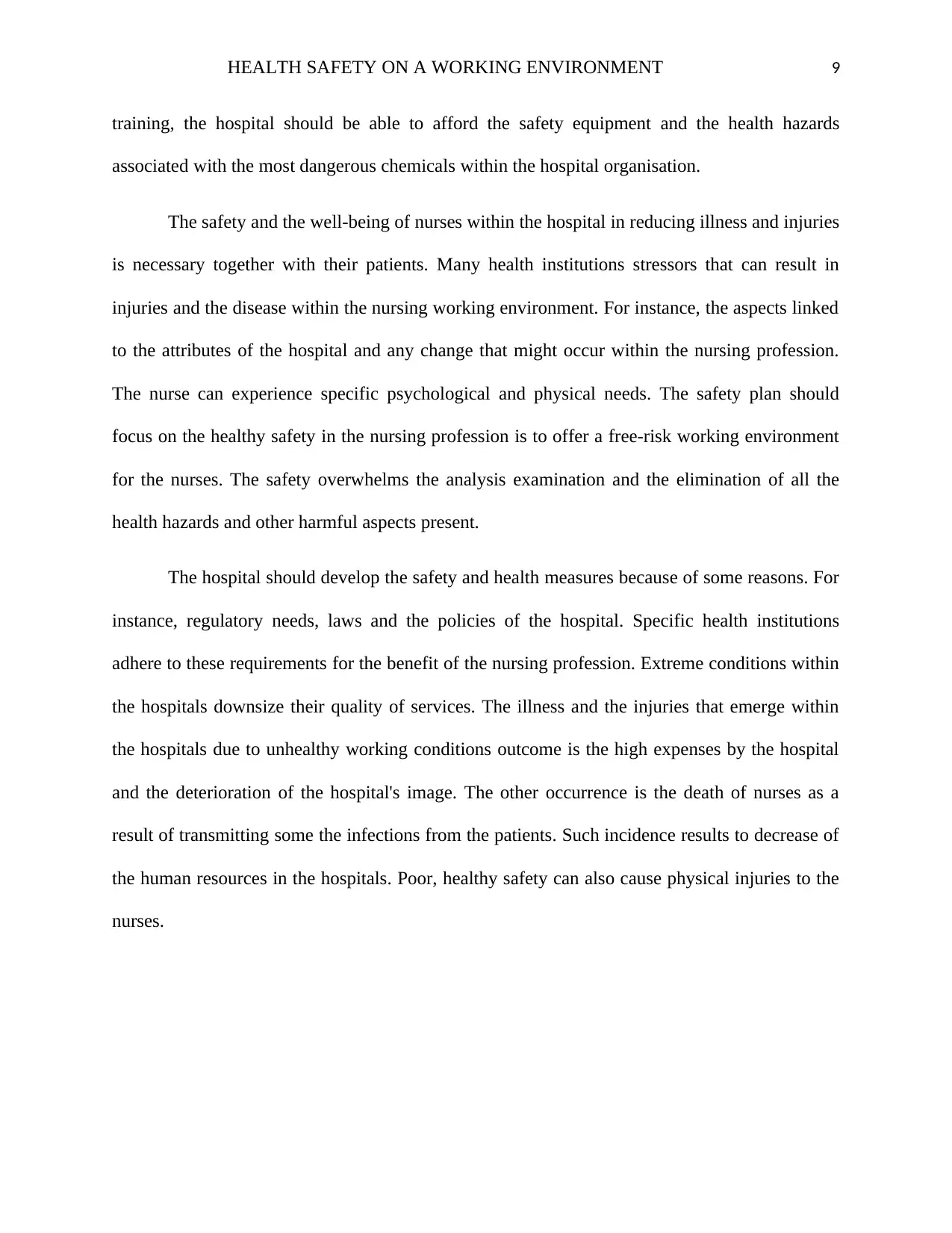
HEALTH SAFETY ON A WORKING ENVIRONMENT 9
training, the hospital should be able to afford the safety equipment and the health hazards
associated with the most dangerous chemicals within the hospital organisation.
The safety and the well-being of nurses within the hospital in reducing illness and injuries
is necessary together with their patients. Many health institutions stressors that can result in
injuries and the disease within the nursing working environment. For instance, the aspects linked
to the attributes of the hospital and any change that might occur within the nursing profession.
The nurse can experience specific psychological and physical needs. The safety plan should
focus on the healthy safety in the nursing profession is to offer a free-risk working environment
for the nurses. The safety overwhelms the analysis examination and the elimination of all the
health hazards and other harmful aspects present.
The hospital should develop the safety and health measures because of some reasons. For
instance, regulatory needs, laws and the policies of the hospital. Specific health institutions
adhere to these requirements for the benefit of the nursing profession. Extreme conditions within
the hospitals downsize their quality of services. The illness and the injuries that emerge within
the hospitals due to unhealthy working conditions outcome is the high expenses by the hospital
and the deterioration of the hospital's image. The other occurrence is the death of nurses as a
result of transmitting some the infections from the patients. Such incidence results to decrease of
the human resources in the hospitals. Poor, healthy safety can also cause physical injuries to the
nurses.
training, the hospital should be able to afford the safety equipment and the health hazards
associated with the most dangerous chemicals within the hospital organisation.
The safety and the well-being of nurses within the hospital in reducing illness and injuries
is necessary together with their patients. Many health institutions stressors that can result in
injuries and the disease within the nursing working environment. For instance, the aspects linked
to the attributes of the hospital and any change that might occur within the nursing profession.
The nurse can experience specific psychological and physical needs. The safety plan should
focus on the healthy safety in the nursing profession is to offer a free-risk working environment
for the nurses. The safety overwhelms the analysis examination and the elimination of all the
health hazards and other harmful aspects present.
The hospital should develop the safety and health measures because of some reasons. For
instance, regulatory needs, laws and the policies of the hospital. Specific health institutions
adhere to these requirements for the benefit of the nursing profession. Extreme conditions within
the hospitals downsize their quality of services. The illness and the injuries that emerge within
the hospitals due to unhealthy working conditions outcome is the high expenses by the hospital
and the deterioration of the hospital's image. The other occurrence is the death of nurses as a
result of transmitting some the infections from the patients. Such incidence results to decrease of
the human resources in the hospitals. Poor, healthy safety can also cause physical injuries to the
nurses.
⊘ This is a preview!⊘
Do you want full access?
Subscribe today to unlock all pages.

Trusted by 1+ million students worldwide
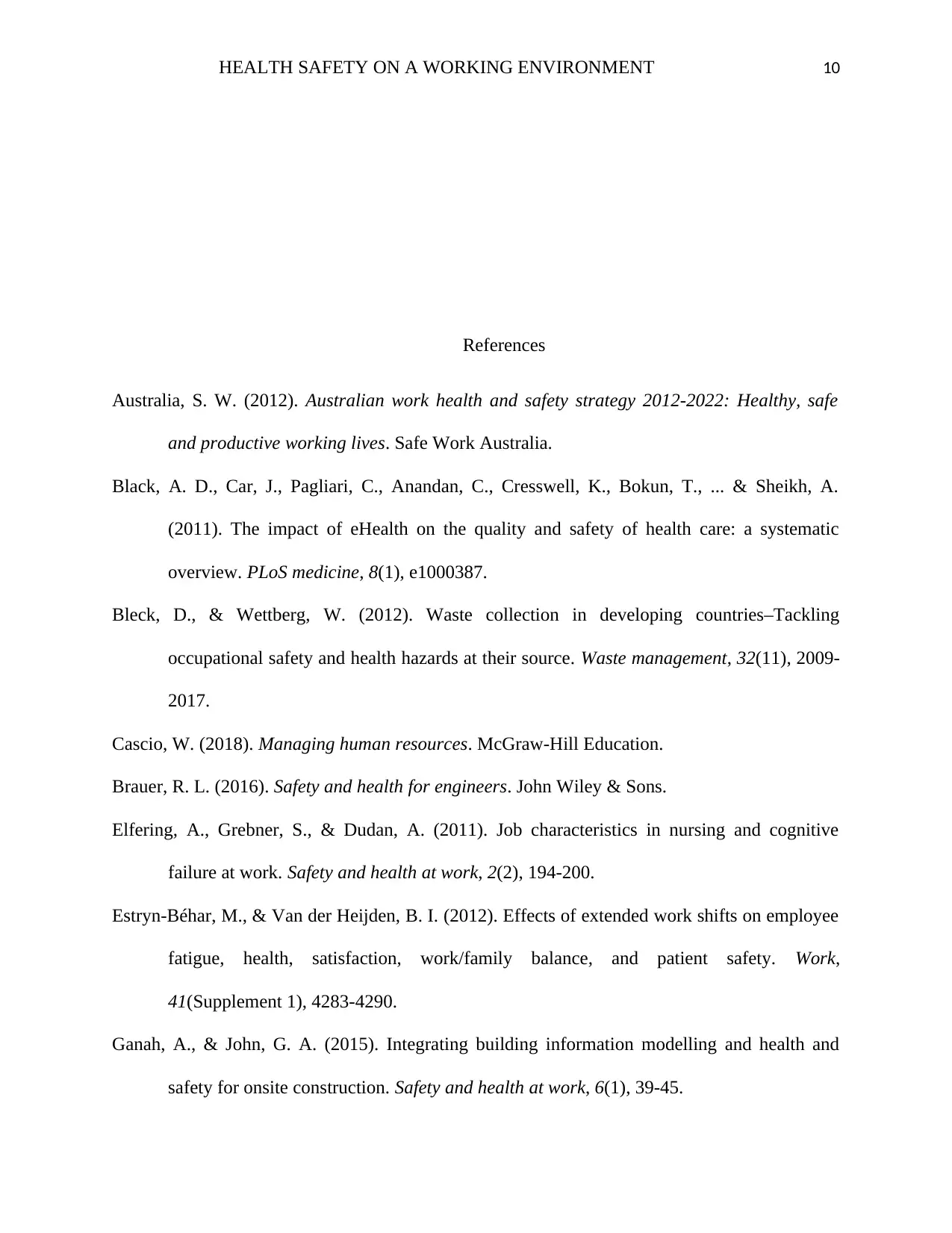
HEALTH SAFETY ON A WORKING ENVIRONMENT 10
References
Australia, S. W. (2012). Australian work health and safety strategy 2012-2022: Healthy, safe
and productive working lives. Safe Work Australia.
Black, A. D., Car, J., Pagliari, C., Anandan, C., Cresswell, K., Bokun, T., ... & Sheikh, A.
(2011). The impact of eHealth on the quality and safety of health care: a systematic
overview. PLoS medicine, 8(1), e1000387.
Bleck, D., & Wettberg, W. (2012). Waste collection in developing countries–Tackling
occupational safety and health hazards at their source. Waste management, 32(11), 2009-
2017.
Cascio, W. (2018). Managing human resources. McGraw-Hill Education.
Brauer, R. L. (2016). Safety and health for engineers. John Wiley & Sons.
Elfering, A., Grebner, S., & Dudan, A. (2011). Job characteristics in nursing and cognitive
failure at work. Safety and health at work, 2(2), 194-200.
Estryn-Béhar, M., & Van der Heijden, B. I. (2012). Effects of extended work shifts on employee
fatigue, health, satisfaction, work/family balance, and patient safety. Work,
41(Supplement 1), 4283-4290.
Ganah, A., & John, G. A. (2015). Integrating building information modelling and health and
safety for onsite construction. Safety and health at work, 6(1), 39-45.
References
Australia, S. W. (2012). Australian work health and safety strategy 2012-2022: Healthy, safe
and productive working lives. Safe Work Australia.
Black, A. D., Car, J., Pagliari, C., Anandan, C., Cresswell, K., Bokun, T., ... & Sheikh, A.
(2011). The impact of eHealth on the quality and safety of health care: a systematic
overview. PLoS medicine, 8(1), e1000387.
Bleck, D., & Wettberg, W. (2012). Waste collection in developing countries–Tackling
occupational safety and health hazards at their source. Waste management, 32(11), 2009-
2017.
Cascio, W. (2018). Managing human resources. McGraw-Hill Education.
Brauer, R. L. (2016). Safety and health for engineers. John Wiley & Sons.
Elfering, A., Grebner, S., & Dudan, A. (2011). Job characteristics in nursing and cognitive
failure at work. Safety and health at work, 2(2), 194-200.
Estryn-Béhar, M., & Van der Heijden, B. I. (2012). Effects of extended work shifts on employee
fatigue, health, satisfaction, work/family balance, and patient safety. Work,
41(Supplement 1), 4283-4290.
Ganah, A., & John, G. A. (2015). Integrating building information modelling and health and
safety for onsite construction. Safety and health at work, 6(1), 39-45.
Paraphrase This Document
Need a fresh take? Get an instant paraphrase of this document with our AI Paraphraser
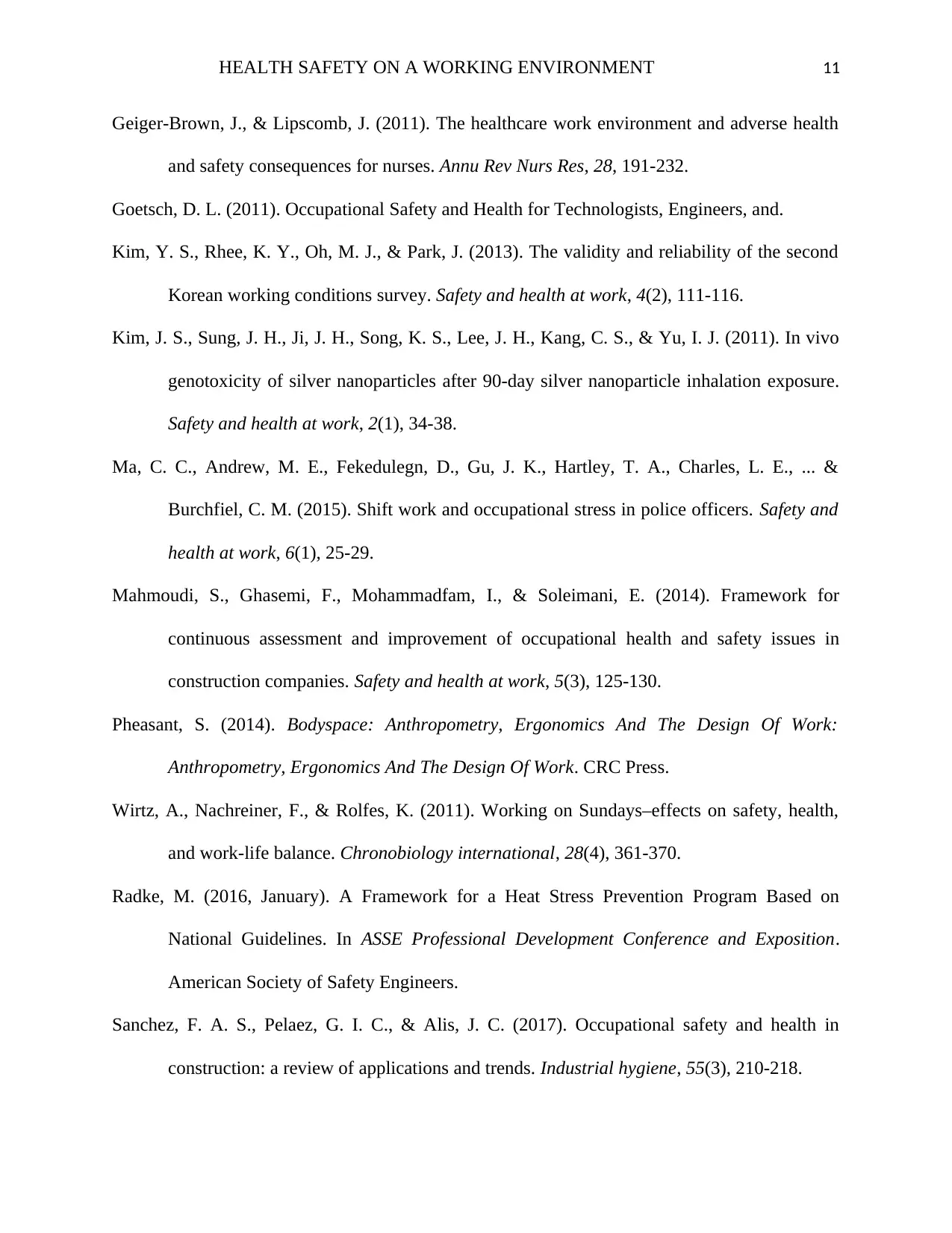
HEALTH SAFETY ON A WORKING ENVIRONMENT 11
Geiger-Brown, J., & Lipscomb, J. (2011). The healthcare work environment and adverse health
and safety consequences for nurses. Annu Rev Nurs Res, 28, 191-232.
Goetsch, D. L. (2011). Occupational Safety and Health for Technologists, Engineers, and.
Kim, Y. S., Rhee, K. Y., Oh, M. J., & Park, J. (2013). The validity and reliability of the second
Korean working conditions survey. Safety and health at work, 4(2), 111-116.
Kim, J. S., Sung, J. H., Ji, J. H., Song, K. S., Lee, J. H., Kang, C. S., & Yu, I. J. (2011). In vivo
genotoxicity of silver nanoparticles after 90-day silver nanoparticle inhalation exposure.
Safety and health at work, 2(1), 34-38.
Ma, C. C., Andrew, M. E., Fekedulegn, D., Gu, J. K., Hartley, T. A., Charles, L. E., ... &
Burchfiel, C. M. (2015). Shift work and occupational stress in police officers. Safety and
health at work, 6(1), 25-29.
Mahmoudi, S., Ghasemi, F., Mohammadfam, I., & Soleimani, E. (2014). Framework for
continuous assessment and improvement of occupational health and safety issues in
construction companies. Safety and health at work, 5(3), 125-130.
Pheasant, S. (2014). Bodyspace: Anthropometry, Ergonomics And The Design Of Work:
Anthropometry, Ergonomics And The Design Of Work. CRC Press.
Wirtz, A., Nachreiner, F., & Rolfes, K. (2011). Working on Sundays–effects on safety, health,
and work-life balance. Chronobiology international, 28(4), 361-370.
Radke, M. (2016, January). A Framework for a Heat Stress Prevention Program Based on
National Guidelines. In ASSE Professional Development Conference and Exposition.
American Society of Safety Engineers.
Sanchez, F. A. S., Pelaez, G. I. C., & Alis, J. C. (2017). Occupational safety and health in
construction: a review of applications and trends. Industrial hygiene, 55(3), 210-218.
Geiger-Brown, J., & Lipscomb, J. (2011). The healthcare work environment and adverse health
and safety consequences for nurses. Annu Rev Nurs Res, 28, 191-232.
Goetsch, D. L. (2011). Occupational Safety and Health for Technologists, Engineers, and.
Kim, Y. S., Rhee, K. Y., Oh, M. J., & Park, J. (2013). The validity and reliability of the second
Korean working conditions survey. Safety and health at work, 4(2), 111-116.
Kim, J. S., Sung, J. H., Ji, J. H., Song, K. S., Lee, J. H., Kang, C. S., & Yu, I. J. (2011). In vivo
genotoxicity of silver nanoparticles after 90-day silver nanoparticle inhalation exposure.
Safety and health at work, 2(1), 34-38.
Ma, C. C., Andrew, M. E., Fekedulegn, D., Gu, J. K., Hartley, T. A., Charles, L. E., ... &
Burchfiel, C. M. (2015). Shift work and occupational stress in police officers. Safety and
health at work, 6(1), 25-29.
Mahmoudi, S., Ghasemi, F., Mohammadfam, I., & Soleimani, E. (2014). Framework for
continuous assessment and improvement of occupational health and safety issues in
construction companies. Safety and health at work, 5(3), 125-130.
Pheasant, S. (2014). Bodyspace: Anthropometry, Ergonomics And The Design Of Work:
Anthropometry, Ergonomics And The Design Of Work. CRC Press.
Wirtz, A., Nachreiner, F., & Rolfes, K. (2011). Working on Sundays–effects on safety, health,
and work-life balance. Chronobiology international, 28(4), 361-370.
Radke, M. (2016, January). A Framework for a Heat Stress Prevention Program Based on
National Guidelines. In ASSE Professional Development Conference and Exposition.
American Society of Safety Engineers.
Sanchez, F. A. S., Pelaez, G. I. C., & Alis, J. C. (2017). Occupational safety and health in
construction: a review of applications and trends. Industrial hygiene, 55(3), 210-218.
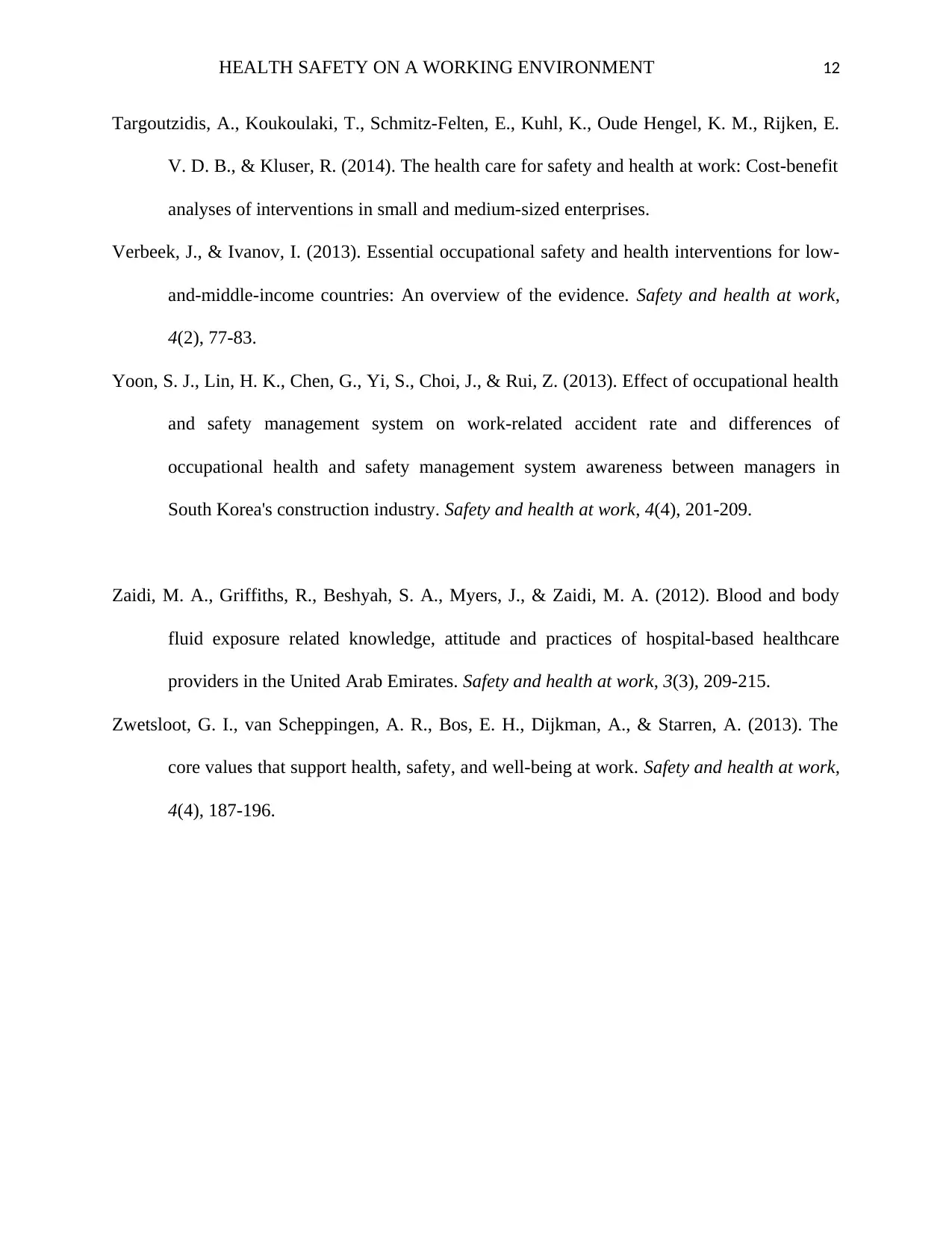
HEALTH SAFETY ON A WORKING ENVIRONMENT 12
Targoutzidis, A., Koukoulaki, T., Schmitz-Felten, E., Kuhl, K., Oude Hengel, K. M., Rijken, E.
V. D. B., & Kluser, R. (2014). The health care for safety and health at work: Cost-benefit
analyses of interventions in small and medium-sized enterprises.
Verbeek, J., & Ivanov, I. (2013). Essential occupational safety and health interventions for low-
and-middle-income countries: An overview of the evidence. Safety and health at work,
4(2), 77-83.
Yoon, S. J., Lin, H. K., Chen, G., Yi, S., Choi, J., & Rui, Z. (2013). Effect of occupational health
and safety management system on work-related accident rate and differences of
occupational health and safety management system awareness between managers in
South Korea's construction industry. Safety and health at work, 4(4), 201-209.
Zaidi, M. A., Griffiths, R., Beshyah, S. A., Myers, J., & Zaidi, M. A. (2012). Blood and body
fluid exposure related knowledge, attitude and practices of hospital-based healthcare
providers in the United Arab Emirates. Safety and health at work, 3(3), 209-215.
Zwetsloot, G. I., van Scheppingen, A. R., Bos, E. H., Dijkman, A., & Starren, A. (2013). The
core values that support health, safety, and well-being at work. Safety and health at work,
4(4), 187-196.
Targoutzidis, A., Koukoulaki, T., Schmitz-Felten, E., Kuhl, K., Oude Hengel, K. M., Rijken, E.
V. D. B., & Kluser, R. (2014). The health care for safety and health at work: Cost-benefit
analyses of interventions in small and medium-sized enterprises.
Verbeek, J., & Ivanov, I. (2013). Essential occupational safety and health interventions for low-
and-middle-income countries: An overview of the evidence. Safety and health at work,
4(2), 77-83.
Yoon, S. J., Lin, H. K., Chen, G., Yi, S., Choi, J., & Rui, Z. (2013). Effect of occupational health
and safety management system on work-related accident rate and differences of
occupational health and safety management system awareness between managers in
South Korea's construction industry. Safety and health at work, 4(4), 201-209.
Zaidi, M. A., Griffiths, R., Beshyah, S. A., Myers, J., & Zaidi, M. A. (2012). Blood and body
fluid exposure related knowledge, attitude and practices of hospital-based healthcare
providers in the United Arab Emirates. Safety and health at work, 3(3), 209-215.
Zwetsloot, G. I., van Scheppingen, A. R., Bos, E. H., Dijkman, A., & Starren, A. (2013). The
core values that support health, safety, and well-being at work. Safety and health at work,
4(4), 187-196.
⊘ This is a preview!⊘
Do you want full access?
Subscribe today to unlock all pages.

Trusted by 1+ million students worldwide
1 out of 12
Related Documents
Your All-in-One AI-Powered Toolkit for Academic Success.
+13062052269
info@desklib.com
Available 24*7 on WhatsApp / Email
![[object Object]](/_next/static/media/star-bottom.7253800d.svg)
Unlock your academic potential
Copyright © 2020–2025 A2Z Services. All Rights Reserved. Developed and managed by ZUCOL.





